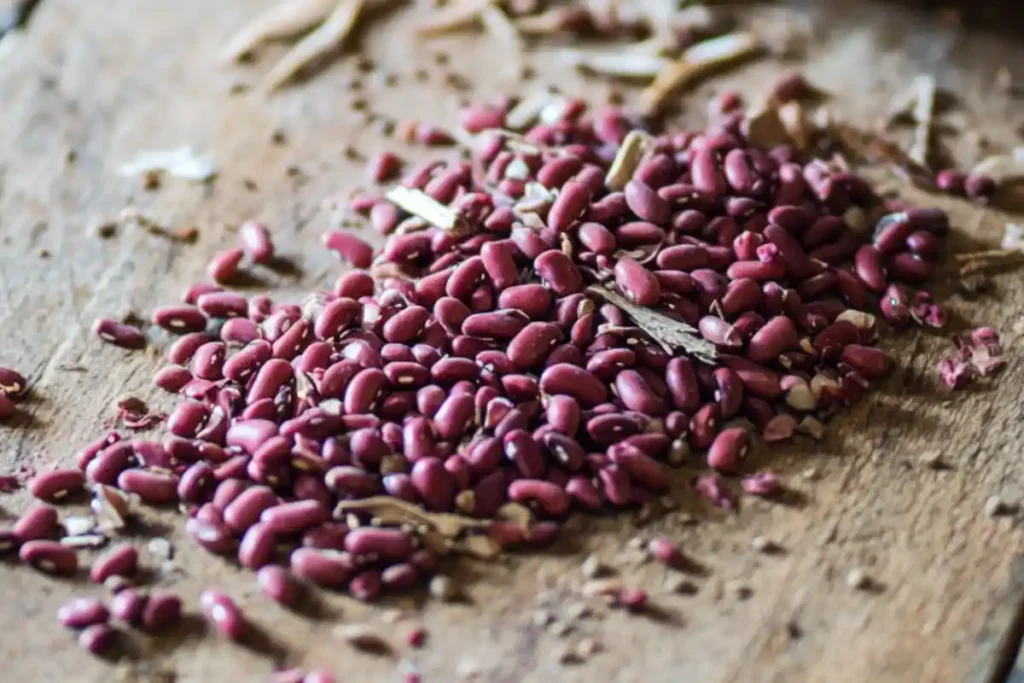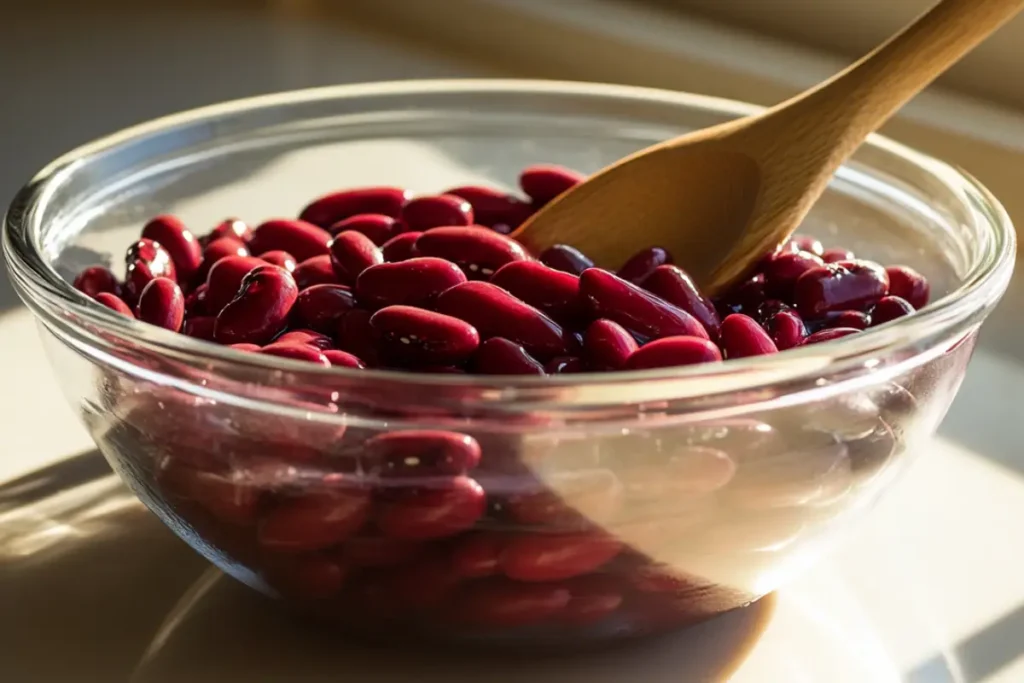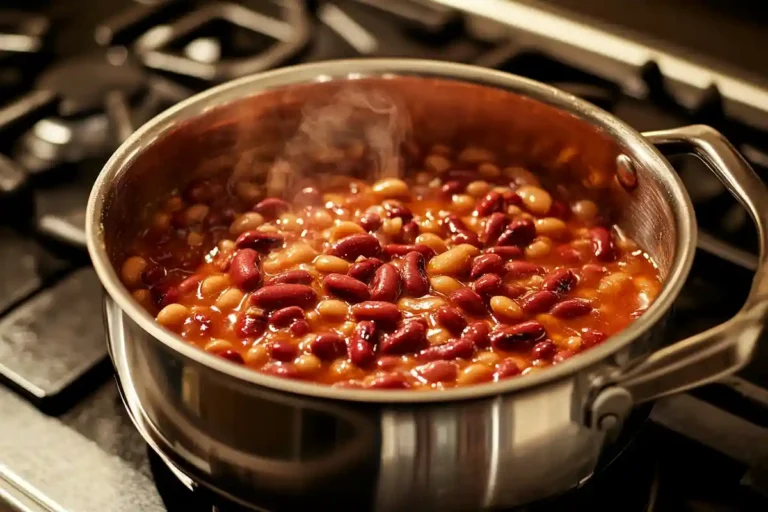1. Understanding Red Kidney Beans
Why can’t you boil red kidney beans? This question often arises for home cooks trying to make a hearty chili or a comforting stew. Red kidney beans are a staple in many cuisines worldwide, especially popular in the United States for dishes like chili con carne, soups, stews, and even cold salads. Known for their vibrant color, kidney shape, and slightly sweet flavor, red kidney beans are packed with essential nutrients. Each bean contains protein, dietary fiber, vitamins, and minerals, making them a powerhouse in a healthy diet—if cooked correctly.
Yet, these same nutritious legumes also come with an important caveat: they must be cooked properly to avoid any risk of foodborne illness. Improper cooking can lead to unexpected, uncomfortable, and sometimes dangerous side effects. To appreciate the right method of cooking, it’s crucial to understand what makes red kidney beans different from other legumes and why they require certain steps.
Nutritional Profile
- Protein: Red kidney beans are a plant-based protein source with about 15 grams of protein per cooked cup.
- Fiber: They provide significant dietary fiber (about 13 grams per cup), which is key for digestive health.
- Vitamins and Minerals: Red kidney beans offer iron, magnesium, potassium, and folate. These nutrients support red blood cell production, muscle function, and overall energy.
Beyond being a nutritious addition to meals, red kidney beans stand out for their hearty texture and unique taste. But before you toss them into a soup or stew, it’s crucial to learn about a naturally occurring toxin that can pose serious health risks if the beans aren’t cooked correctly.
2. What Makes Red Kidney Beans Potentially Dangerous?

When people first hear about the dangers of red kidney beans, they often wonder, “What could possibly be so hazardous?” The answer lies in a compound called phytohaemagglutinin (PHA). This substance is a naturally occurring lectin found in many types of beans, but it’s particularly concentrated in red kidney beans. Lectins, in general, can cause digestive distress if consumed in high amounts, and PHA is one of the more potent varieties.
The Role of Phytohaemagglutinin
Phytohaemagglutinin can cause a cluster of symptoms sometimes referred to as “red kidney bean poisoning.” While it’s rarely life-threatening, it can be extremely uncomfortable and may include:
- Nausea
- Vomiting
- Diarrhea
- Abdominal cramps
These symptoms typically appear within a few hours of consuming undercooked red kidney beans. The good news is that thorough cooking destroys enough of this toxin to make the beans safe to eat. However, the key is understanding the difference between simply boiling the beans (especially at a lower temperature) and cooking them at a rolling boil for a sufficient length of time.
The Temperature Factor
A common mistake is thinking that simmering beans at a low temperature for a long duration is safe. Unfortunately, that’s not correct for red kidney beans. If you do not raise the beans to a rapid boil for at least 10 minutes, the levels of phytohaemagglutinin might still be dangerously high.
Many recipes advise a rapid boil at the start of cooking, followed by a lengthy simmer. This two-tier approach effectively breaks down the toxin. Without the initial rapid boil, you risk leaving the toxin intact, even if you simmer the beans for hours. That’s why it’s often stated you can’t “just boil” red kidney beans in a standard pot of simmering water: you need that rapid, high-temperature phase.
3. Common Mistakes When Cooking Red Kidney Beans
Mistakes often happen due to simple oversights or following incomplete cooking instructions. Here are a few common errors:
- Skipping the Soaking Step: Many people attempt to cook dried kidney beans without soaking them first. While some beans can be prepared without soaking, red kidney beans have a harder coat and a higher concentration of PHA. Skipping or rushing the soak can lead to undercooked beans.
- Using a Slow Cooker Incorrectly: Slow cookers are convenient, but they operate at lower temperatures. If you put raw or improperly soaked red kidney beans in a slow cooker, the heat may never reach the level required to neutralize PHA. Always presoak and perform a rapid boil before transferring beans to a slow cooker.
- Relying on Low-Simmer Methods: Some cooks turn the heat down to a gentle simmer right from the start. For red kidney beans, the initial rapid boil is vital. Simply simmering is not enough to destroy the lectin effectively.
- Undercooking to Maintain “Firmness”: Some recipes might suggest undercooking beans to keep them slightly firm, but red kidney beans must be fully cooked for safety. While you can maintain some texture, never cut the cooking process short just to avoid a “mushy” bean.
Understanding these pitfalls makes it clear that cooking red kidney beans demands attention to detail. Proper technique is non-negotiable if you want to prevent any digestive or toxic effects.
4. Step-by-Step Instructions for Safely Cooking Red Kidney Beans

Now that we’ve established why it’s unsafe to just boil red kidney beans at a low temperature, let’s look at how to cook them safely. This step-by-step guide ensures you neutralize the toxin and end up with soft, flavorful beans perfect for any recipe.
1. Sorting and Rinsing
- Inspect the Beans: Spread the dried red kidney beans on a tray or countertop to check for any debris like small stones or twigs. Discard any malformed or discolored beans.
- Rinse Thoroughly: Place the beans in a colander and rinse them under cold running water. This step helps remove dust or surface dirt.
Sorting and rinsing might seem trivial, but it helps guarantee that you begin the process with the cleanest beans possible. Plus, removing damaged beans early ensures a more consistent cooking result.
2. Soaking
- Overnight Soak Method: Transfer your rinsed beans into a large bowl and cover with several inches of water. Leave them to soak for at least 8 hours, preferably overnight.
- Quick Soak Method: If you’re short on time, place the beans in a pot, cover with water, and bring to a rapid boil for 2-3 minutes. Turn off the heat, cover the pot, and let the beans sit for about an hour.
Soaking is critical for red kidney beans because it starts the process of breaking down the lectin. Additionally, it shortens the cooking time, which means less energy consumption and a lower chance of ending up with beans that are partially cooked.
3. Rapid Boil
- Drain and Rinse: After soaking, drain the beans and rinse them again under cold running water.
- Add Fresh Water: Place the beans in a pot and add enough fresh water to cover them by about 1–2 inches.
- Rapid Boil for 10 Minutes: Bring the water to a rolling boil. Keep the heat at the highest setting to sustain that boil for at least 10 minutes.
This rapid boil is the essential step that many people overlook. Maintaining a vigorous boil ensures that any residual phytohaemagglutinin is denatured. Without this phase, the toxins might remain potent.
4. Simmer to Perfection
- Reduce Heat: After the initial rapid boil, lower the heat to a gentle simmer.
- Cooking Time: Let the beans cook for an additional 45–60 minutes, or until they reach the desired tenderness. This can vary based on factors like altitude and the age of the beans.
- Test Frequently: Taste a bean periodically to check for tenderness. Red kidney beans should be soft but not falling apart.
By the end of this simmering phase, your beans will be both safe and delicious. They’ll be ready for use in chili, stews, salads, or any recipe that calls for hearty legumes.
5. Tips & Tricks for Perfectly Cooked Red Kidney Beans
Cooking red kidney beans safely doesn’t have to be intimidating. Here are some additional pointers to ensure perfect beans every time:
- Use Quality Beans: Old or poorly stored beans can remain tough no matter how long you cook them. Purchase fresh, high-quality dried beans from a reliable source to avoid prolonged cooking times.
- Mind the Salt: Adding salt too early can sometimes toughen the beans’ outer skin. Consider adding salt after the initial rapid boil. Then adjust seasoning to taste towards the end of cooking.
- Cook in Batches: If you frequently use red kidney beans, cook a large batch at once. Properly cooked beans can be portioned and stored in airtight containers in the refrigerator for up to five days. For longer storage, freeze them.
- Wait on the Acids: Ingredients like tomatoes, vinegar, or lemon juice can slow down the cooking process if added too early. Introduce acidic components only after the beans have begun to soften.
- Use the Right Equipment: A heavy-bottomed pot helps maintain a consistent temperature and prevents beans from scorching at the bottom.
These small adjustments can make a big difference in both the safety and taste of your final dish. Red kidney beans are versatile and can be adapted to a wide range of recipes, but it all starts with a safe, thorough cook.
6. Flavor Variations and Recipe Ideas
Once you’ve mastered the art of cooking red kidney beans safely, you can enjoy them in countless ways. Below are some flavor-packed suggestions that highlight the beans’ natural richness and work well for U.S. and global palates alike.
- Classic Chili con Carne
- Ingredients: Cooked red kidney beans, ground beef (or turkey), onions, garlic, chili powder, tomatoes.
- Tips: Let the chili simmer for at least 30 minutes after adding the beans to develop a robust flavor.
- Hearty Bean Soup
- Ingredients: Cooked red kidney beans, mixed vegetables (carrots, celery, onions), chicken or vegetable broth, herbs like thyme and bay leaves.
- Tips: Mash a few beans against the pot’s side to add creaminess without extra fats.
- Red Bean and Rice Bowl
- Ingredients: Cooked red kidney beans, white or brown rice, bell peppers, onions, Cajun seasoning, sausage (optional).
- Tips: Sauté onions and peppers in olive oil, then add seasoning and beans. Serve over rice for a quick, flavorful meal.
- Kidney Bean Salad
- Ingredients: Cooked red kidney beans, diced cucumbers, cherry tomatoes, feta cheese (optional), lemon juice, olive oil.
- Tips: Chill cooked beans before adding them to raw vegetables. Dress with olive oil, lemon juice, salt, and pepper for a light, protein-packed meal.
- Spicy Kidney Bean Curry
- Ingredients: Cooked red kidney beans, onions, tomatoes, ginger, garlic, chili powder, garam masala.
- Tips: Start by sautéing onions, ginger, and garlic in oil. Add spices, tomatoes, and beans, then let the flavors meld for at least 20 minutes.
No matter which recipe you choose, make sure your red kidney beans have gone through the essential steps—soaking, rapid boil, and thorough simmer—to guarantee they are safe to eat and full of flavor.
7. Frequently Asked Questions (FAQs)
Below are the top four frequently asked questions about red kidney beans, based on People Also Ask (PAA). Optimizing for these common queries helps clarify lingering doubts and ensures you have all the information you need.
1. Why shouldn’t you boil kidney beans?
You should boil red kidney beans—but the key is how and when you do it. The phrase “Why shouldn’t you boil kidney beans?” often refers to the danger of partial or improper boiling. If you bring them to only a gentle simmer rather than a full rolling boil, you may not neutralize the toxin phytohaemagglutinin. This can result in food poisoning symptoms. It’s not that you can’t boil them at all; you must rapidly boil them for at least 10 minutes before simmering to ensure they’re safe to eat.
2. Can you boil red kidney beans?
Yes, you can—and you should. Boiling is a critical step in destroying the lectin that can cause digestive distress. After soaking, bring your beans to a rolling boil for at least 10 minutes. Then, reduce the heat and simmer until fully cooked. This two-step process guarantees that the beans are safe for consumption and still taste delicious.
3. What is the toxin in red kidney beans?
The naturally occurring toxin in red kidney beans is phytohaemagglutinin (PHA). This lectin can cause gastrointestinal issues, including nausea and vomiting, if the beans are not adequately cooked. High-temperature boiling for a minimum of 10 minutes is necessary to denature this toxin. Once the beans reach a rolling boil at the correct temperature, PHA levels reduce significantly, making the beans perfectly safe to eat.
4. How to make kidney beans not poisonous?
To ensure red kidney beans are not poisonous, follow these steps:
- Sort and Rinse: Remove debris and rinse the beans thoroughly.
- Soak Properly: Soak the beans overnight or use the quick-soak method.
- Rapid Boil: Boil the beans vigorously for at least 10 minutes.
- Simmer: Lower the heat and cook until tender.
This method effectively destroys harmful levels of phytohaemagglutinin, leaving you with safe, delicious beans ready for any recipe.
Conclusion
Red kidney beans are a beloved ingredient in countless U.S. kitchens, celebrated for their hearty texture, rich flavor, and impressive nutritional profile. Yet the question “Why can’t you boil red kidney beans?” continues to puzzle many home cooks. The answer lies in understanding that a simple simmer isn’t enough to neutralize the toxin phytohaemagglutinin.
To ensure your beans are both delicious and safe:
- Sort and Rinse: Remove any debris and rinse well.
- Soak Thoroughly: Overnight soaking or a quick-soak method is essential.
- Rapid Boil: Ten minutes of a rolling boil eliminates the majority of the toxin.
- Simmer to Finish: Lower the heat and cook until the beans reach perfect tenderness.
These steps are non-negotiable for properly cooking red kidney beans. By following these guidelines, you can avoid the pitfalls that lead to digestive issues and confidently incorporate red kidney beans into your favorite meals. Whether it’s a comforting bowl of chili, a robust curry, or a refreshing salad, properly cooked red kidney beans can add both nutrition and flavor to your table.
Happy cooking—and enjoy your safely prepared red kidney beans!

